Timoleague Friary
Timoleague Friary (Irish: Mainistir Thigh Molaga),[1] also known as Timoleague Abbey, is a ruined medieval Franciscan friary located in Timoleague, County Cork, Ireland. It is located on the site of an early Christian monastic site founded by Saint Molaga, from whom the town of Timoleague derives its name. The present remains date from roughly the turn of the fourteenth century and were burnt down by British forces in the mid-seventeenth century.
Mainistir Thigh Molaga | |
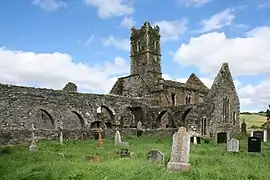 | |
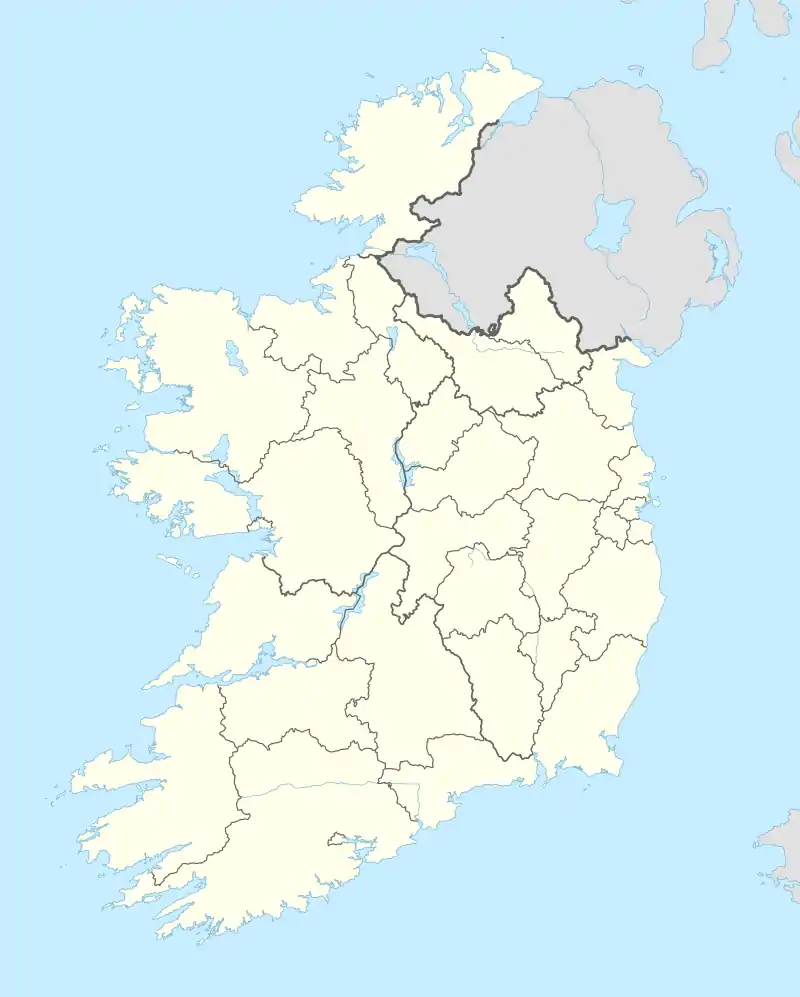 Location within Ireland | |
| Monastery information | |
|---|---|
| Order | Franciscans |
| Established | c.1240 |
| Disestablished | 1631 |
| Diocese | Cork and Ross |
| People | |
| Founder(s) | Domhnall Got MacCarthy or William de Barry |
| Architecture | |
| Status | Inactive |
| Style | Early English Gothic |
| Site | |
| Location | Timoleague, County Cork, Ireland |
| Coordinates | 51.64250°N 8.76306°W |
| Public access | Yes |
| Official name | Timoleague Friary |
| Reference no. | 21 |
The largest medieval ruin in West Cork, Timoleague is one of the few early Franciscan friaries in Ireland to have substantial ruins.[2] It is situated on the banks of the Argideen River overlooking Courtmacsherry Bay.[3] There are several historical artefacts associated with the friary, and during the Romantic era it featured in several notable artworks. Listed as a discovery point on the Wild Atlantic Way, the ruins are open to public access.[4]
History
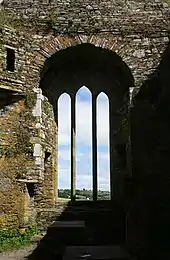
Early history
The friary sits on a monastic site dedicated to Saint Molaga dating to either the 6th[4] or 7th century.[5] According to legend, it was originally to be built a mile west of Timoleague, but all work done on that site by day would fall down by morning.[6] Interpreting this as God's will that the friary be built elsewhere, Molaga supposedly placed a blessed candle on a sheaf of corn, and set it down the Argideen river, building his settlement on the spot that it came ashore.[7] The town derives its Irish name, Teach Molaga or "Molaga's House" from the saint.[8]
The date of foundation by the Franciscans is disputed. Documentary evidence places the foundation of the friary between 1307 and 1316, though physical evidence suggests that a preexisting 13th century building was incorporated into the site.[9] According to the Annals of the Four Masters, the friary was founded in 1240 by the native Irish MacCarthy Reagh family.[3] This has been identified as possibly being too early.[10] Some sources ascribe this claimed foundation to Domhnall Got MacCarthy,[3] while others claim that Got MacCarthy merely expanded the friary anywhere between 1312 and 1366.[11][12] Domhnall's grandson, Domhnall Glas MacCarthy, is also thought to have been a patron of the abbey.[9] Samuel Lewis, in A Topographical Dictionary of Ireland... (1837) claims that the MacCarthy's founded the abbey in 1312.[13] The friary's foundation has also been attributed to the Anglo-Norman de Barry family in the early 14th century.[3] Though the friars were well established in Timoleague by 1320, the earliest surviving parts of the ruined friary date from later in the 14th century. It is likely that they were based in Timoleague Castle prior to the construction of the friary.[10]
By the 15th century, the friary was recognised as a centre of learning, and also as an important ecclesiastical centre.[14][15] In 1460, Timoleague was one of the first houses in the Franciscan order to recognise the observantine reform.[16] Tadhg Mac Cárthaigh, also known as "Blessed Thaddeus", is said to have been educated by the friars around this time.[17] An important patron of the church was Bishop John Edmond de Courcy, along with his nephew James, 8th Baron Kingsale. They funded the construction of the Gothic style bell tower, the infirmary, the library, and one of the dormitories.[18] De Courcy had been a friar in Timoleague before being made a bishop. The tower was added in 1510.[19] They also contributed to the friary's collection of plate.[18] John de Courcy was buried in the transept of the friary, but in the Cromwellian period his grave was desecrated and his bones thrown into the estuary.[18]
Following the dissolution of the monasteries in 1540 by Henry VIII, the Franciscans remained resident in Timoleague until 1568, when the friary was seized by crown forces.[3] After the succession of James I, the Abbey was reclaimed by Catholics in 1603, and was repaired in its entirety by the end of 1604.[20][13]
Abandonment and destruction
In 1612, Bishop Lyons came to Timoleague to disperse the friars but was repelled by an Irish force led by Daniel O'Sullivan.[3][21] In 1629, four years after the death of King James, Richard Boyle was named Lord Justice and instigated the closure of religious buildings across Cork, putting increasing pressure on the friary.[22] It is assumed, however, that the friary was already largely abandoned by the Franciscans by this point, as the guardian appointed to the friary, Eugenius Fildaeus, was appointed in Limerick, in Loco refugii.[23] By 1631 the friary had been largely plundered by Protestant settlers,[9] and it was eventually burnt down by crown forces in July 1642, when a force led by Lord Kinelmeaky failed to capture Timoleague Castle and instead burnt the abbey and much of the town.[22] The friary at one time engaged in significant trade with Spain, and an account of the burning of the friary states that:
We burnt all the towne, and their great Abbey, in which was some thousand barrels of wine.[24]
The destruction of the friary led to a significant downturn in the financial development of the town.[22]
As ruins
After the friary was burnt, local families began to bury their dead within the friary regardless of status, something which previously had only been done for prominent local families.[25] Despite the burning of the friary, the Franciscan community of Timoleague survived for close to two centuries.[26] In 1696 four friars were reportedly living in the ruined monastery.[27] The last Franciscan friar working in the area was Fr Edmund Tobin (also known as Bonaventure Tobin),[28] who died circa 1822.[19] The Franciscans appointed titular guardians of the friary up until 1872.[28] The last guardian of Timoleague friary was Patrick Carey.[29] Interest in the friary was renewed during the Romantic era of the early 19th century, and many paintings and sketches of the friary exist from this period.[30] On 15 January 1848, Fr Matt Horgan, writing under the pen-name "Viator", wrote the following which was released in the Cork Examiner:
"The walls [of the friary] are washed by the tide and some large breaches are already made in the burying ground, much to the disgrace of the lord of the soil, who must be either some heartless absentee, or a Gothic resident, having no feeling of fatherland; irrespective of its history or monuments, thinking only of bullocks, and knowing nothing, and caring less for the arts; blind to the beauties, with heart closed against the romance and poetry of the glorious past, and its mute but still eloquent memorials."
Soon after the publication of these remarks, Colonel Robert Travers, the so-called "lord of the soil", had the walls of the friary grounds replaced, and a road built between them and the sea, all at his own expense.[30] In 1891, mass was celebrated in the friary for the first time since it was burnt down 249 years prior.[31] One of the Timoleague chalices (the Dale-Browne Chalice) was used on the occasion.[32] In 1892, Denham Franklin wrote that
"The preservation of the abbey is mainly due to the care bestowed on it by the family of the present proprietor of Timoleague, Mr. Robert Travers, who did not allow the depredations unfortunately too common on our ancient buildings."
In 1920, in response to the murder of three police officers by Irish nationalists, British soldiers desecrated the abbey's burial ground. Burial vaults were opened, and the flags that had been draped over the coffins within were torn and cast aside. Coffins were opened, and in some cases, human remains were left visible.[33]
In 1955, Irish-language writer Máire Ní Shíthe was interred in the abbey in an unmarked grave. In 2016 the location of her burial was identified, and a commemorative stone placed above it.[34]
Architecture
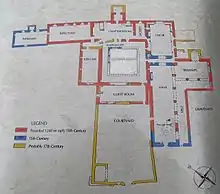
The use of locally available freestone was typical in the construction of Franciscan friaries of the period,[35] and Timoleague Friary is no exception, having been made from locally-sourced slate,[36] quarried in nearby Borleigh.[37] It is built in the Early English Gothic architectural style.[38] Despite the extensive standing remains, the friary was once much larger than it is today. Records show that in the late 1500s the friary had a mill attached to the main structure, and that the monastery stood on a 4.5 acre site — four times larger than what is left of the friary grounds today.[39]
At the entrance to the nave, now used as the main entrance to the friary, a fleur-de-lis is engraved on the left jamb. The original monks were likely French speaking, and would have used the fleur-de-lis as an aid to describe the Holy Trinity. A small recess above the door was used to hold either a sculpture or other religious imagery.[39] The nave was considerably smaller when the friary was first constructed; it features an arcade of six arches, only three of which are original.[40]
In Spittal, a nearby townland, there was a leprosarium, and as a result, the south window of the transept was known as the "Leper's Hole" — a gap through which sufferers of leprosy could see and hear the service, and partake in the Blessed Sacrament.[31] The window is narrower on the outside than it is on the inside, and the Eucharist was likely passed out by the monks on a spoon so as to avoid contact with a disease which was considered highly contagious at the time.[41]
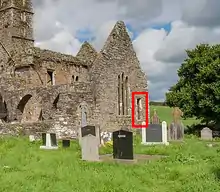
The choir is the oldest part of the friary, and it has been suggested that it may have originally been an early 13th century castle, or that it was originally a church that the Franciscans later added to. The choir is notably tall and features unusual components such as tall arches and wall passages.[41] It features four widely splayed arched recesses in the north and south walls.[9] A niche on the northern wall once contained an altar in memory of the de Courcey family. The great window in the choir faces east, and once contained elaborate stained glass imagery.[41]
The sacristy features a bullaun stone, commonly known as a wart well as the water in the depression was said to heal warts. This stone is far older than any other aspect of the friary, and may have originally been associated with the original 6th or 7th century monastic site.[42]
On the exterior wall, a protruding stone is known as "St Molaga's Head". A gift given by French sailors as thanksgiving for safe harbour following a storm at sea, it was originally a sculpture of Molaga's head, but the facial features have been completely eroded with time.[42]
A room generally considered to have been the library is the only section the friary not in use as a burial ground. This may have been the place of residence of the friars who remained in Timoleague after the destruction of the friary.[43] The windows present in the remaining ground floor of this room would not have been sufficient for literary work; and the library was actually more likely to have been on the upper floor.[44]
The friary featured a cloister, though only a portion of the walls remain standing. The cloister and the living quarters of the monks are located to the north of the church, which is typical of Irish Franciscan friaries.[9] The cloister quadrangle would have covered an area 9.8 metres (32 ft) across by 9.3 metres (30.5 ft) wide.[45] In the south of wall of the cloister is an intra-mural space known locally as "The Fairy Cupboard". In the 1800s, some local children supposedly entered the Fairy Cupboard and disvocered a parchment manuscript beneath one of the flagstones, which they used as a football before the remainder was eaten by pigs.[46]
The bell tower is one of fourteen pre-reformation towers built in Franciscan monasteries that still stand today.[47] The tower is wider from north to south than from west to east, a feature typical of Franciscan towers. It measures 4.0 metres (13 ft) from west to east and 4.6 metres (15 ft) from north to south. Also typical is the abrupt narrowing of the cross-walls from the north and south at the point where the tower begins. The tower is more obviously battered than most Franciscan towers.[48] The tower is battlemented, as are almost all surviving towers. The top of the tower has three merlons rising to each of its four corners.[49]
Historical artefacts
Book of Lismore
_frontispiece.jpg.webp)
Leabhar Leasa Móir, or the Book of Lismore, also known as Leabhar Mhic Cárthaigh Riabhaigh, is a 15th century manuscript with connections to the friary.[50] Though some sources claim that the manuscript was written or partly written in the friary,[4][14] Professor Pádraig Ó Macháin, an expert on Irish manuscripts, says that that is not the case.[51]
It was held in the friary at times, and material from the book was transcribed there by Mícheál Ó Cléirigh in 1629.[52][53]
Timoleague Chalices
Two 17th century chalices, - both of which are referred to as the "Timoleague Chalice" - are associated with the friary.[54]
The first chalice, also known as the "Dale-Browne Chalice", or the "Dale Chalice",[55] is made of gilt silver and was created circa. 1600.[56] After the suppression of the monastery, one of the friars supposedly escaped with the chalice, disguised himself, and lived as a farmer.[57] His dying wish was that the chalice, along with his vestments, be buried in a box beneath his house, and that they remain buried until the abbey was restored and the friars had returned. Years later, the house was undergoing renovations and the box was discovered. The contents were given to Franciscans in Cork.[57] The chalice is engraved with the words "Orate · Pro · Animabvs · Caroli · Dali · Et · Elizie · Browne · TimoLeagve." around the base, which translates as "Pray for the souls of Charles Daly and Elizabeth Browne, Timoleague".[58] The chalice is 8.5 inches tall, with the tulip-shaped bowl measuring 3.25 inches wide and 3 inches deep.[56] The chalice's primary decoration is on one facet of its tall hexagonal foot. It depicts a selection of the Instruments of the Passion: a cross in the centre, a spear to one side, and a stick with a sponge to the other. The cross is depicted as the tree of life, with branches sprouting from its tip and base, and shamrocks forming its head and arms.[59] The chalice was likely a gift from the Dalys (Elizabeth Browne being Charles' wife) to the friars upon their return to the friary after its suppression in 1568. It is currently in the possession of the National Museum of Ireland.[58]
The second chalice, also known as the "Timoleague Franciscan Chalice",[60] is made of gold and was deemed by experts to have been created in 1633.[61] When the friary was burnt down, three friars supposedly fled via rowboat.[62] The friars were found at sea by fishermen from Cape Clear Island, by which point two of them had died.[61] A box was left with the fishermen by the surviving friar, with instructions that they not open it, as the friar would one day return for it, though he never did.[61][62] The box was opened in 1860, and was found to contain a set of severely deteriorated vestments and a chalice that was "black with age". The chalice is engraved with the words "ffr'MinConv de Thimolaggi", which translates as "Friars Minor Convent of Timoleague".[61][54] In 1892, 250 years after the chalice was removed from the town, it was returned to the parish priest of Timoleague.[60] It has remained in the safekeeping of his successors,[54] and an exact replica of the chalice is on permanent display in the local Catholic church.[63]
In culture
_p093_CORK_-_TIMOLEAGUE_ABBEY.jpg.webp)
Among William Ashford's earliest landscape works is a rough drawing of the friary, Timoleague (abbey ruins).[65] Ashford further painted two watercolours of the ruins in 1776.[66]
Seán Ó Coileáin, an Irish language poet, wrote the poem Machtnadh an Duine Dhoilghiosaich about the ruins of the abbey in either 1813[67] or 1814.[68] Writing in 1831, James Hardiman described it as one of the "finest modern poems in the Irish language".[69] It has been translated to English several times, including as The Mourner's Soliloquy in the Ruined Abbey of Timoleague and as Lament over the Ruins of the Abbey of Teach Molaga by Sir Samuel Ferguson.[69][70] A bronze cast of one of the verses in the original Irish is located at the entrance gate of the ruins.[71]
Gallery
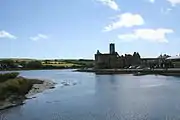 View of Timoleague Friary
View of Timoleague Friary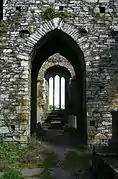 Interior of church
Interior of church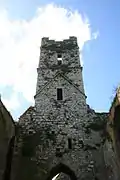 Bell tower
Bell tower
References
Notes
- Crowley 2016, p. 1.
- Finola (26 October 2014). "Timoleague Friary". Roaringwater Journal. Retrieved 29 August 2021.
{{cite web}}: CS1 maint: url-status (link) - "Timoleague Franciscan Friary | Monastic Ireland". www.monastic.ie. Retrieved 4 May 2017.
- "Timoleague Abbey". Wild Atlantic Way Ireland Map and Guide. Retrieved 29 August 2021.
- Keohane 2020, p. 578.
- M, S (1 November 1834). "Timoleague Abbey". The Dublin Penny Journal. Retrieved 29 August 2021.
- Crowley 2016, p. 5.
- Cochrane 1912, p. 14.
- Keohane 2020, p. 579.
- Coombes 1969, p. 17.
- D'Imperio 2013.
- Franklin 1892, p. 174.
- Lewis 1837, p. 625.
- Whooley 2015, p. 104.
- Whooley 2015, p. 112.
- Coombes 1968, p. 157.
- "Blessed Thaddeus McCarthy". Catholic Saints. Retrieved 1 September 2021.
{{cite web}}: CS1 maint: url-status (link) - Coombes 1969, p. 18.
- "Timoleague (Co. Cork)". Franciscans. Retrieved 29 August 2021.
{{cite web}}: CS1 maint: url-status (link) - Archdall 1873, p. 147.
- Franklin 1892, p. 175.
- Whooley 2015, p. 108.
- Franklin 1892, p. 176.
- Cochrane 2021, p. 21.
- Crowley 2016, pp. 7–8.
- Coombes 1969, p. 35.
- Franklin 1892, p. 178.
- Coombes 1969, p. 51.
- Mould 1991, p. 94.
- Coombes 1969, p. 52.
- O'Mahony 1892, p. 109.
- O'Mahony 1892, pp. 109–110.
- Donnelly 2012, p. 151.
- Ó Donnabháin 2016, p. 8–10.
- Mooney 1956, pp. 128–127.
- Wilkinson 1845, p. 146.
- Kinahan 1887, p. 244.
- Kinahan 1888, p. 354.
- Crowley 2016, p. 7.
- Cochrane 2021, p. 14.
- Crowley 2016, p. 9.
- Crowley 2016, p. 10.
- Crowley 2016, p. 11.
- Cochrane 2021, p. 15.
- Mooney 1957, p. 16.
- Crowley 2016, p. 13.
- Mooney 1957, p. 2.
- Mooney 1957, pp. 6–7.
- Mooney 1957, pp. 9–10.
- "Book of Lismore". UCC Library Guide. October 2020. Retrieved 29 August 2021.
{{cite web}}: CS1 maint: url-status (link) - Leland 2011.
- "The Book of Lismore". celt.ucc.ie. Retrieved 7 September 2021.
- Crowley 2016, p. 12.
- Coombes 1969, p. 53.
- Krasnodębska-D'Aughton 2009.
- Day 1897, p. 46.
- Dalton 1892, p. 228.
- Hallinan 2021, p. 231.
- Hallinan 2021, p. 232.
- Buckley 1943, p. 185.
- "Community Notes March 23". Argideen Rangers. 19 March 2019. Retrieved 1 September 2021.
{{cite web}}: CS1 maint: url-status (link) - Kelly 2014.
- Crowley 2016, p. 15.
- "Untitled Post - Argideen Rangers GAA". sites.google.com. Retrieved 3 January 2022.
- Crookshank 1995, p. 120.
- "OMNIA - [Two watercolour paintings of 'Timoleague Abbey' (Co. Cork) / by William Ashford.]". www.omnia.ie. Retrieved 3 January 2022.
- Kilfeather 2006, p. 92.
- Färber 2014.
- Hardiman 1831, p. 410.
- Färber 2011.
- Crowley 2016, p. 6.
Sources
- Archdall, Mervyn (1873). Monasticon Hibernicum: Or, A History of the Abbeys, Priories, and Other Religious Houses in Ireland; Interspersed with Memoirs of Their Several Founders and Benefactors, and of Their Abbots and Other Superiors, to the Time of Their Final Suppression, Volume 1. Ireland. p. 147.
 This article incorporates text from this source, which is in the public domain.
This article incorporates text from this source, which is in the public domain. - Buckley, J.J. (31 March 1943). "Some Irish Altar Plate (The "Timoleague Franciscan" Chalice)". The Journal of the Royal Society of Antiquaries of Ireland. 7. Royal Society of Antiquaries of Ireland. 13 (1): 185–200. JSTOR 25510377 – via JSTOR.
- Cochrane, Dr. Robert (January–March 1912). "Notes on the Structures in the County of Cork vested in the Board of Works for Preservation as Ancient Monuments: Part I - Timoleague Friary, County Cork". Journal of the Cork Historical and Archaeological Society. 2. XVIII (93): 14–25.
- — (2021) [1913]. Ancient and National Monuments in the County of Cork. Cork: Coolim Books. pp. 14–25. ISBN 978-1-9196506-0-9.
 This article incorporates text from this source, which is in the public domain.
This article incorporates text from this source, which is in the public domain. - Coombes, James (1968). "The Benedictine Priory of Ross" (PDF). Journal of the Cork Historical and Archaeological Society. 73 (218): 157.
- — (July 1969). Timoleague and Barryroe. Timoleague. p. 52.
{{cite book}}: CS1 maint: date and year (link) - Crookshank, Anne (1995). "A Life Devoted to Landscape Painting: William Ashford". Irish Arts Review. 11: 119–130.
- Crowley, Helen; et al. (2016). Timoleague Friary (Mainistir Thigh Molaga): Self Guided Tour Booklet. With the assistance of Flor Hurley, Dr Anne Julie Lafaye, and Monastic Ireland. Timoleague, Co. Cork: Molaga Tidy Towns Association, history sub-committee. pp. 1–14.
- Dalton, John Paul (November 1892). "Notes and Queries: A Relic of Timoleague Abbey" (PDF). Cork Historical and Archaeological Society. 1: 228.
- Day, Robert (1897). "The altar plate of the Franciscan Church, Cork" (PDF). Journal of the Cork Historical and Archaeological Society. 2. 3 (26): 44–50.
- D'Imperio, Antonio (22 June 2013). "Timoleague Friary". Irish Stones. Retrieved 29 August 2021.
{{cite web}}: CS1 maint: url-status (link) - Donnelly, James S. Jr. (2012). "Big House Burnings in County Cork during the Irish Revolution, 1920–21*" (PDF). Éire-Ireland. 47 (3): 141–197. doi:10.1353/eir.2012.0021. S2CID 161570386.
- Franklin, Denham (September 1892). "Timoleague Abbey" (PDF). Journal of the Cork Historical and Archaeological Society. 1: 173–178.
- Färber, Beatrix (3 August 2011). "Lament over the Ruins of the Abbey of Teach Molaga". Corpus of Electronic Texts Edition: UCC. Retrieved 2 September 2021.
{{cite web}}: CS1 maint: url-status (link) - — (4 February 2014). "Machtnadh an Duine Dhoilghiosaich". The Corpus of Electronic Texts: UCC. Retrieved 2 September 2021.
{{cite web}}: CS1 maint: url-status (link) - Hallinan, Mona; Nelligan, Conor; Sleeman, Mary, eds. (2021). Heritage Artefacts of County Cork. Cork: Cork County Council; Heritage Unit. pp. 231–233. ISBN 978-1-911677-03-1.
- Hardiman, James (1831). "The Mourner's Soliloquy in the Ruined Abbey of Timoleague". Irish Minstrelsy, or Bardic Remains of Ireland; with English Poetical Translations. Vol. 2. London. pp. 401–411.
 This article incorporates text from this source, which is in the public domain.
This article incorporates text from this source, which is in the public domain. - Harding, James D.; O'Callaghan Newenham, Robert (1830). Picturesque Views of the Antiquities of Ireland. Vol. 1. Strand: Thomas and William Boone. p. 7.
 This article incorporates text from this source, which is in the public domain.
This article incorporates text from this source, which is in the public domain. - Kelly, Pat (20 March 2014). "Timoleague Chalice". Irish Examiner. Retrieved 1 September 2021.
- Keohane, Frank (2020). The Buildings of Ireland: Cork City and County. New Haven and London: Yale University Press. pp. 578–580. ISBN 978-0-300-22487-0.
- Kilfeather, Siobhán (2006). "The Gothic novel". In Foster, John Wilson (ed.). The Cambridge Companion to the Irish Novel. Cambridge, United Kingdom: Cambridge University Press. p. 92. ISBN 978-0-521-67996-1.
- Kinahan, George Henry (23 March 1887). "Arenaceous Rocks". Journal of the Royal Geological Society of Ireland: Economic Geology of Ireland. XVIII: 205–318.
- — (18 January 1888). "Slates and Clays. Part I.—Slates,". Journal of the Royal Geological Society of Ireland: Economic Geology of Ireland. XVIII: 327–391.
- Krasnodębska-D'Aughton, Małgorzata (8 December 2009). "Dale-Browne Chalice". UCD Digital Library. doi:10.7925/drs1.ivrla_29952. Retrieved 1 September 2021.
{{cite journal}}: CS1 maint: url-status (link) - Leland, Mary (8 July 2011). "Lost and found: the leabhar of Lismore comes home". The Irish Times. Retrieved 1 September 2021.
- Lewis, Samuel (1837). A Topographical Dictionary of Ireland. Vol. 2. London: Lewis & Co. pp. 625–626.
 This article incorporates text from this source, which is in the public domain.
This article incorporates text from this source, which is in the public domain. - Mooney, Canice (1956). "Franciscan Architecture in Pre-Reformation Ireland (Part II)". The Journal of the Royal Society of Antiquaries of Ireland. 86: 125–169 – via JSTOR.
- — (1957). "Franciscan Architecture in Pre-Reformation Ireland (Part III)". The Journal of the Royal Society of Antiquaries of Ireland. 87: 1–38 – via JSTOR.
- Mould, Daphne Desiree Charlotte Pochin (1991). "The Medieval Monasteries". Discovering Cork. Dingle, Ireland: Brandon Book Publishers. pp. 84–99. ISBN 0-86322-129-7.
- Ó Donnabháin, Traolach (22 August 2016). "Máire Ní Shíthe (1867 - 1955): 'Dul Amú' - 'The Gaelic Authoress'" (PDF). Michael Collins News. Michael Collins Centre. pp. 8–10. Retrieved 8 March 2022.
- O'Donovan, Diarmaid (3 January 2021). "Welcome return of 'Book of Lismore'". The Southern Star. Retrieved 1 September 2021.
- O'Mahony, John (11 May 1892). "Proceedings of the Society" (PDF). Journal of the Cork Historical and Archaeological Society. 1: 109–110.
- Wilkinson, George (1845). "The Geology and Architecture of Ireland". The Civil Engineer & Architect's Journal: Scientific and Railway Gazette. VIII: 144–148.
- Whooley, Dónal (2015). "The Old Order Changeth:The development of Timoleague as a significant town and its subsequent decline in the medieval period" (PDF). Clonakilty Historical & Archaeological Journal. 1: 101–116.
Further reading
- Timoleague Abbey in 'The Dublin Penny Journal' (19th century)
- Andy Halpin; Conor Newman (26 October 2006). Ireland: An Oxford Archaeological Guide to Sites from Earliest Times to AD 1600. OUP Oxford. pp. 533–. ISBN 978-0-19-151317-6.
External links
- Lament over the Ruins of the Abbey of Teach Molaga an English translation of Machtnadh an Duine Dhoilghiosaich, a poem written in 1814 by Seághan Ó Coileáin about the friary, translated by James Clarence Mangan.